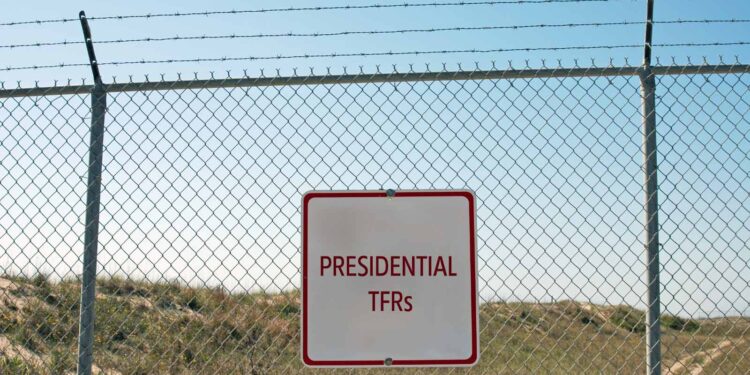Presidential TFRs – Impact on Bizav: Part 2 – Dealing with TFR Restrictions

This business aviation blog post continues from our article last week, titled “Presidential TFRs – Impact on Bizav: Part 1 – Closure Areas and Restrictions.”
In order to experience the least potential operational impact from a Presidential Temporary Flight Restriction (TFR), always check the FAA website – beginning 72 hours prior to time of operation. Note that during VIP TFR closures you may need to revise your schedule, to operate outside of closure hours, or to choose a different destination airport.
The following is an overview of what you need to know:
1. Ramp and airside closures
There are usually ramp closures associated with presidential TFRs. You may be able to access a fixed-base operator (FBO) but will not be permitted to go out to your aircraft. If Air Force One or Air Force Two is on the field, and the president and/or vice president is not at the airport, restrictions may or may not be in place depending on security protocols. Ramp issues are most common when you’re parked in an area close to presidential or vice-presidential aircraft.
2. Roving and longer-term presidential TFRs
From time to time roving TFRs may be put into effect, covering airport and non-airport locations. This may be the case when the president is involved in a local campaign tour. Roving TFRs may, at times, be announced on short notice and exact closure periods may not be published or may change at a moment’s notice. In some cases, such as when the president is on vacation, airspace surrounding an airport and/or the president may be closed for longer than normal periods.
3. Impact on GA
Presidential TFRs have the potential to significantly impact general aviation (GA) operations. During presidential TFRs airspace closures it’s usually not possible to fly over protected airspace below FL 180. Nearby airports, within the protective rings of airspace, may not be available to GA over a certain time period. These “no-fly” areas may lead to re-routing your flight or the requirement to use different approach/departure procedures when operating to airports adjacent to a TFR closure area.
4. Ground restrictions
Ramp restrictions in place during presidential TFRs usually mean that you’ll not be able to access, service or fuel your aircraft during the closure period. Prior to arrival of the presidential or vice-presidential aircraft an advance team will land, often with a Lockheed C5 Galaxy transport, to position presidential motorcade equipment. There are times when GA aircraft, parked at the airfield, will be moved to different areas of the ramp prior to arrival of the presidential advance team or presidential aircraft. In some cases these TFR closures temporarily affect transient parking availability at particular airports.
5. Operating exemptions
Under presidential or vice-presidential TFRs operators on IFR flight plans are often permitted to overfly outer rings of protected airspace so long as they’re at or above FL 180 and maintain communication with ATC. There are occasions, however, where specific guidance is given and you may not be permitted to overfly inner or outer rings of a presidential TFR, at any altitude. In certain cases, exemptions may be issued by TSA, allowing operators to fly over or land within a TFR area. For example, this may be the case with law enforcement fixed-wing or rotor wing, firefighting or military aircraft directly supporting the Secret Service, and/or medevac or air ambulance flights. In such cases you’ll be provided with a unique code that must be placed in the ICAO section of your flight plan.
6. Planning for presidential TFR closures
The best way to plan for these types of TFRs is to check the FAA website, type in the state you’re operating to/from and check for any published TFRs. Note that posted presidential TFRs are subject to change, so it’s best to check daily for any applicable TFRs and/or TFR changes.
7. More information on presidential TFRs
The official source for U.S. TFR information is the FAA’s Graphical TFR web page and FDC NOTAMs. Both provide information regarding any VIP TFRs that are scheduled or in effect. It should be noted, however, that TFR NOTAMs are often somewhat difficult to decipher. The National Business Aviation Association (NBAA), as a service to its members, provides easier-to-comprehend notifications and graphical depictions of VIP TFRs. These notifications include a synopsis of TFR details highlighting:
- Type and dimension of the TFR
- Times the TFR will be in effect
- Specific airports impacted by the TFR and times of these impacts
- Additional guidance as needed
Conclusion
While there may be opportunities to operate through or into outer ring protected airspace associated with a presidential TFR there’ll be specific guidance, from FAA and TSA, to follow. While a presidential TFR is in effect, SIDS and STARS for airports close to the inner ring of the active TFR may be altered during the time of the airspace closure. For this reason it’s always recommended to check for active TFRs that may affect your flight.
Questions?
If you have any questions or would like flight planning assistance, contact me at markrobinson@univ-wea.com.



